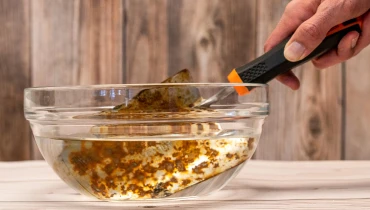Best Way to Remove Rust From Tools

Are you looking for the best way to remove rust from tools? Neglecting the rust on your tools can lead to corrosion and unrepairable damage. By following these tips from Mr. Handyman, you can protect your tools so they’re ready when you need them.
Why Are Your Tools Rusty?
Rusty tools are typically a result of water settling on metal. The good news is you don’t have to throw out your tools just because they’ve accumulated rust. As long as corrosion hasn’t set in (holes in the metal), you will be able to remove rust from the surface and continue using your tools as usual.
How to Remove and Prevent Rust on Tools
Ready to remove pesky and unsightly rust from your tools? This is a project you can easily tackle at home.
Here are the supplies you’ll need, depending on the method you choose for rust removal. The method you use will depend on how bad the rust is on the tool.
- A penetrating oil product like WD-40
- Clean cloth
- Steel wool
- Coarse-grit and fine-grain sandpapers
- White vinegar
- Salt
- Containers large enough to hold the tools
- Oxalic acid (commercial rust-remover product)
- Protective eye gear and rubber gloves
You may not need all of these items to remove rust from your tools. You can start with one method and move on to the next until you achieve your desired results.
Here are the methods you can use to make your tools rust-free and like new:
Method #1: Penetrating Oil and Steel Wool
For light surface rust, spraying a product like WD-40 and rubbing the surface vigorously with steel wool may be enough to clean the tools. Wash and dry thoroughly.
Method #2: Sanding
After using the degreasing product to clean your tools, wipe away any remaining debris or dirt with a clean cloth. Allow the tools to dry, and use steel wool to clean away existing rust. Next, use the coarse-grit sandpaper to sand away thicker rust patches. Follow up with the finer-grain sandpaper if spots of rust remain. Rinse and dry the tools thoroughly.
Method #3: White Vinegar and Salt
If you have tools with large sections of rust, this method may remove the rust without having to use acid. After degreasing, cleaning, and drying the tools, place each tool in a container large enough to hold the entire piece. Fill the container with a sufficient amount of vinegar to submerge the tool and then sprinkle with salt to cover the surface of the tool evenly. The ideal amount of salt and vinegar is ¼-cup salt per liter of vinegar. Allow the tools to sit in the solution long enough to soften the rust, which may be a time period of 24 hours to three days. Check on your tools from time to time, and if you notice the rust is softening, use the steel wool to scrub it away. Thoroughly rinse and dry the tools once you have removed all signs of rust.
Method #4: Commercial Rust Remover: Oxalic Acid
For more stubborn areas of rust that you can’t remove with the previous methods, oxalic rust should do the trick. This commercial rust remover works to dissolve rust rapidly. If used improperly oxalic acid can be dangerous, so always read the label and use caution when working with it. Wear protective eye gear and rubber gloves and work in a well-ventilated area when using this method.
After degreasing, cleaning, and drying the tools, place the tools in containers and fill them with one gallon of water per container. Add 3 tablespoons of oxalic acid to the water and mix carefully, avoiding splashes and spills. Place the tools into the containers and allow them to soak in the solution for up to 20 minutes, or as the product label directs. After soaking, remove the tools from the container and rinse away the softened rust and acid residue in water, and dry thoroughly.
Tips for Keeping Your Tools Rust-Free:
- Keep your tools away from water. If they come in contact with moisture (rain, snow, humid air), dry them thoroughly as soon as possible.
- Include moisture-absorbing gel packs in your toolbox or drawer to control the humidity level.
- Apply a protective wax coating to tools; automotive paste-type wax is ideal for this purpose.
- Keep all tools in a toolbox or tool bench so they stay safe, dry, and rust-free until you are ready to use them.
Contact Mr. Handyman
Need a custom tool bench in your garage or work area to prevent rust on your tools? Contact your local Mr. Handyman and let us build the perfect bench for your space to keep your tools clean and organized. Schedule an appointment online now or call us today.
 Click to call
Click to call


